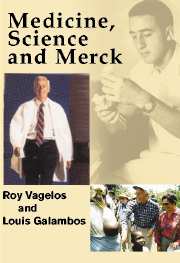Book contents
- Frontmatter
- Contents
- Preface
- 1 The Making of a Physician
- 2 Hot Science in Big Government
- 3 The French Alternative
- 4 The Research University – American Style
- 5 Turning the Corner at Merck
- 6 Crisis
- 7 Blockbusters
- 8 On-the-Job Training
- 9 Global Aspirations
- 10 The Moral Corporation
- 11 Getting to Know the Clintons
- 12 Partners
- Index
7 - Blockbusters
Published online by Cambridge University Press: 30 July 2009
- Frontmatter
- Contents
- Preface
- 1 The Making of a Physician
- 2 Hot Science in Big Government
- 3 The French Alternative
- 4 The Research University – American Style
- 5 Turning the Corner at Merck
- 6 Crisis
- 7 Blockbusters
- 8 On-the-Job Training
- 9 Global Aspirations
- 10 The Moral Corporation
- 11 Getting to Know the Clintons
- 12 Partners
- Index
Summary
Look,” Dr. Illingworth said, “high cholesterol is killing people.” Roger Illingworth of Portland, Oregon, was a prominent heart specialist. He and two fellow cardiologists from Dallas were visiting Merck in 1982 as consultants to give us an outside perspective on our programs at the laboratories. In their clinical practices all three were treating patients with serious artery diseases, their coronary arteries narrowed by plaques of cholesterol and fat. Not coincidentally, these patients also had elevated cholesterol levels that hadn't responded to any of the available treatments. The three clinicians were in complete agreement: “Mevacor was doing a helluva job in the clinic,” Scott Grundy said. “Why don't you let us try it in some high-risk patients?” Illingworth, Grundy, and his colleague David Bilheimer were eager to restart limited clinical trials because the outlook for their patients was dire.
Having spent several years caring for such patients on the wards of the National Heart Institute, I knew they were right. As the head of Merck's research labs, I was tempted but hesitant. The evidence these and other medical researchers had uncovered pointed to elevated cholesterol levels (hypercholesterolemia) as a major cause of heart disease, and I knew that the high-risk patients Grundy, Bilheimer, and Illingworth were treating had been unable to bring their cholesterol levels down to a safe range either through diets or drugs. In many such cases, badly clogged arteries left the patients facing almost certain encounters with life-threatening heart attacks.
- Type
- Chapter
- Information
- Medicine, Science and Merck , pp. 152 - 174Publisher: Cambridge University PressPrint publication year: 2004

